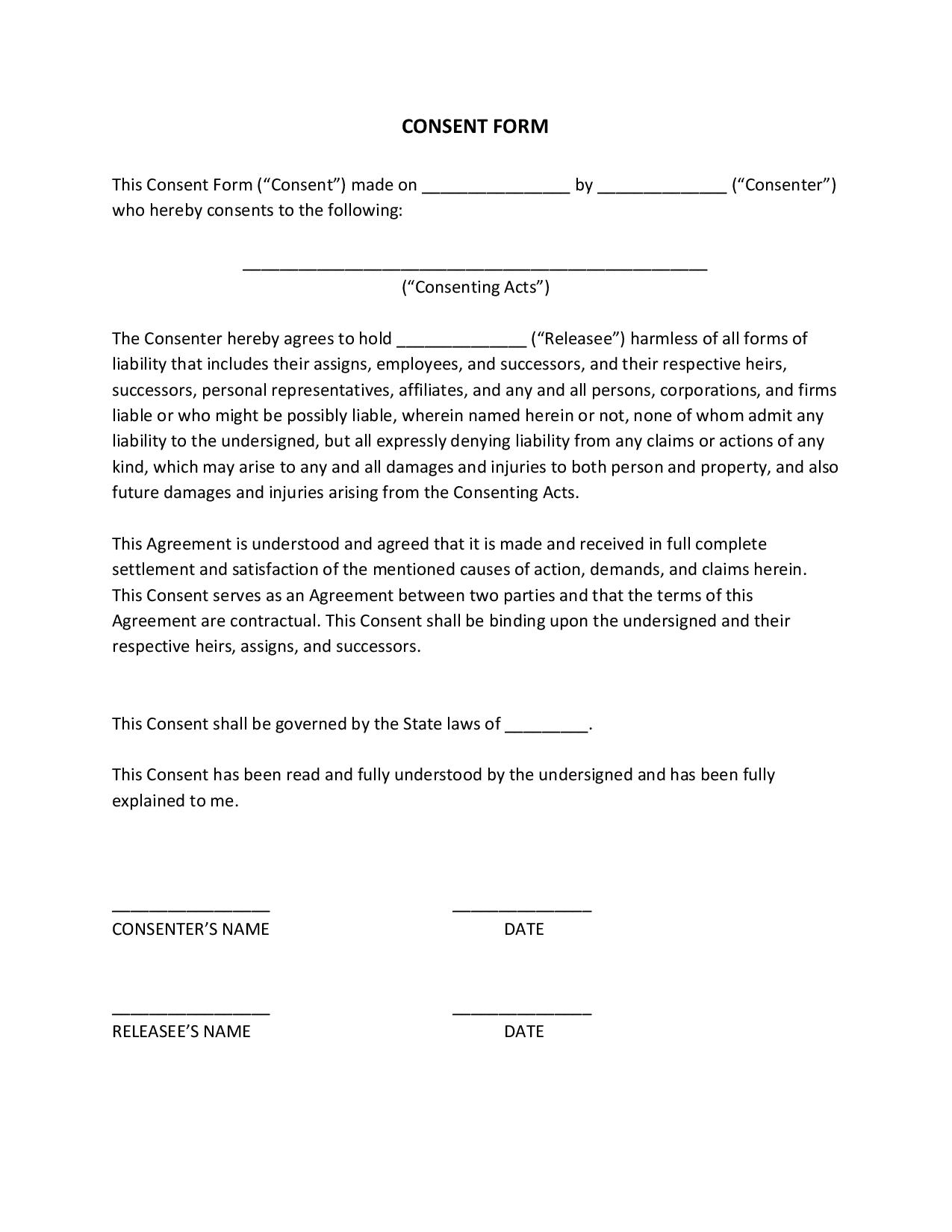- Eviction Notice Forms
- Power of Attorney Forms Forms
- Bill of Sale (Purchase Agreement) Forms
- Lease Agreement Forms
- Rental Application Forms
- Living Will Forms Forms
- Recommendation Letters Forms
- Resignation Letters Forms
- Release of Liability Agreement Forms
- Promissory Note Forms
- LLC Operating Agreement Forms
- Deed of Sale Forms
- Consent Form Forms
- Support Affidavit Forms
- Paternity Affidavit Forms
- Marital Affidavit Forms
- Financial Affidavit Forms
- Residential Affidavit Forms
- Affidavit of Identity Forms
- Affidavit of Title Forms
- Employment Affidavit Forms
- Affidavit of Loss Forms
- Gift Affidavit Forms
- Small Estate Affidavit Forms
- Service Affidavit Forms
- Heirship Affidavit Forms
- Survivorship Affidavit Forms
- Desistance Affidavit Forms
- Discrepancy Affidavit Forms
- Guardianship Affidavit Forms
- Undertaking Affidavit Forms
- General Affidavit Forms
- Affidavit of Death Forms
Consent Form
Consent is a sign of respect and an exercise of an individual’s right over their bodies and choices. Violation of such could make a person answerable in the court of law. It comes in the form of speech, writing, and non-verbal cues. A consent form is the perfect instrument if you want to give your written consent to another individual or entity. This gives them the go signal to perform the consenting acts without the fear of violating a basic human right. Know more about this form by reading below. Read More

What Is a Consent Form?
A consent form, in its simplistic sense, is an instrument used to give permission from one individual to another individual or entity. The consenter is initially informed about the possible risks involved before an event or activity. This form is used in commonly used in the medical field, wherein it indemnifies the surgeon or hospital from any lapses that come with the risks of the surgery or procedure. This is called informed consent. A consent form is also used prior to the release of photography, video, and sound release.
How to Write a Consent Form
You must explicitly state all consented acts to prevent any unwanted misuse, abuse, or violation. Create a clear and concise general consent form with the help of these tips:
1. Specify the Type of Form Needed
There are a lot of consent form types that are used in different fields. The type of consent form can be used for school affairs, research, counseling, etc. It is important to determine the type of form needed first in order to list down all the corresponding consenting acts. You may use an appropriate template to lessen the hassle on your part.
2. Stipulate Your Name as the Consenter
The consent form is a form of agreement between the consenter and the releasee. You trust the releasee to carry out the consenting acts in your best interest. Start the consent form by indicating your name as the consenter along with the effective date.
3. List the Consenting Acts
The type of form identifies the list of consenting acts to be carried out. For example, if the consent form pertains to informed consent of dental implant surgery, the dentist needs to perform certain actions to carry out the surgery such as using different forms of sedation, cutting open and pulling away the gum tissue, suturing the gums, etc. The dentist is required to be as transparent as possible because if lapses occur and the patient was not informed about it prior, they could be sued for medical malpractice.
4. Include Terms
The terms of the consent form mainly consist of indemnifications. Referring to the same example, the patient cannot sue the dentist if they were informed beforehand of the risks and complications. The possible risks and complications of the surgery are laid out in case they occur. They are also given the chance to back out if they do not agree with the information contained in the form. The terms must be clear, concise, and written in understandable language to avoid confusion for the releasee.
5. Sign the Consent Form
Sign the consent form with the releasee once all the key parts are included. But before signing the form, you must make sure that the language used is easy to understand and informative. Take note that the minors cannot sign the consent form, the signing must be administered by a parent or a legal guardian.
Frequently Asked Questions
What are the five types of consent?
The five types of consent are expressed, informed, implied, substituted, and unanimous consent. The first type is self-explanatory; the second type is used in the medical field wherein the patient is informed beforehand of the procedure; the third type is dependent on facts or the current circumstances, e.g., combat or contact sports; the fourth one is where a parent or legal guardian gives consent for a minor; lastly, the unanimous consent is a consent given collectively, e.g., corporation, cooperative, etc.
Why should I use a consent form?
Consent forms are used to get permission from the consenter. The consenter usually gives a specific list of consenting acts that the releasee is allowed to execute. Consent forms are not one size fits all—they are used according to their purpose, and a one-time consent does not necessarily mean a subsequent consent.
What is informed consent?
Informed consent is when a patient is informed about the procedure or surgery prior to the actual operation. In this form, the background of the surgery such as the method and possible risks and complications are laid out for the patient. This will help them decide whether to carry on or back out. This is a protocol for the people in the medical field to inform the patient beforehand of the procedure’s background. Failure to do this will get them sued for medical malpractice.
How long should a consent last?
In the medical field, a consent form is good indefinitely until revoked by the patient.
Is informed consent an ethical issue?
Yes. Informed consent is an ethical issue because patients should have the right to information, and at the same time, they should also have the right to refuse due to religious or personal reasons. Informed consent also helps the patient be aware of the risks and complications of the procedure, and have the right to decline.
Consent is freely given to those who deserve it. It is a basic human right that dictates us that we are entitled to our bodies and choices. Even after death, medical practitioners cannot just freely donate your organs without your prior consent—that’s how valued consent is even after death. As the consenter, you have full authority of the actions that you are consenting to. That’s why it pays to be careful and aware of what you are allowing the releasee to do. A written consent is one of the effective ways of giving permission to someone, especially if the act to be executed contains a sense of formality.

